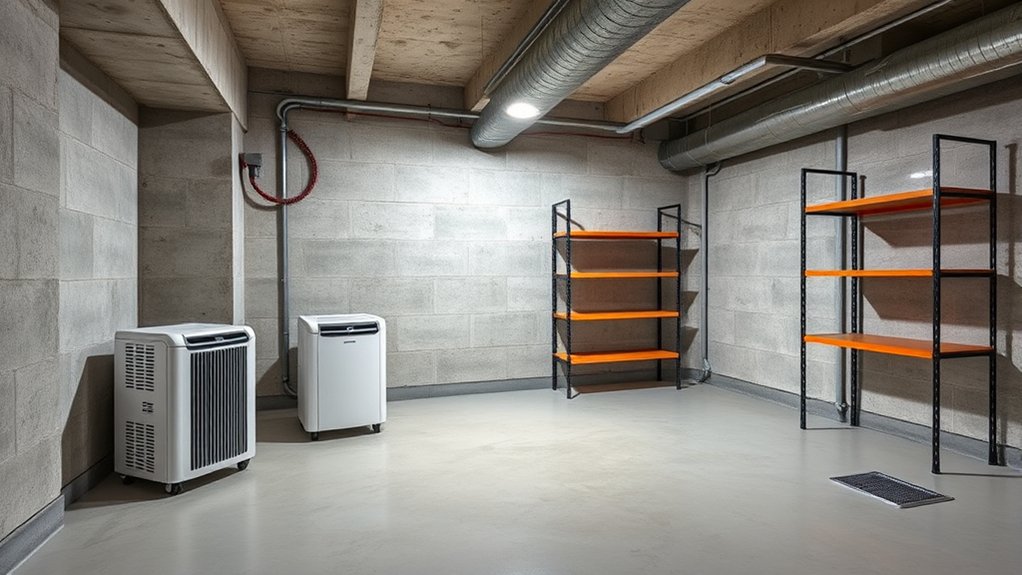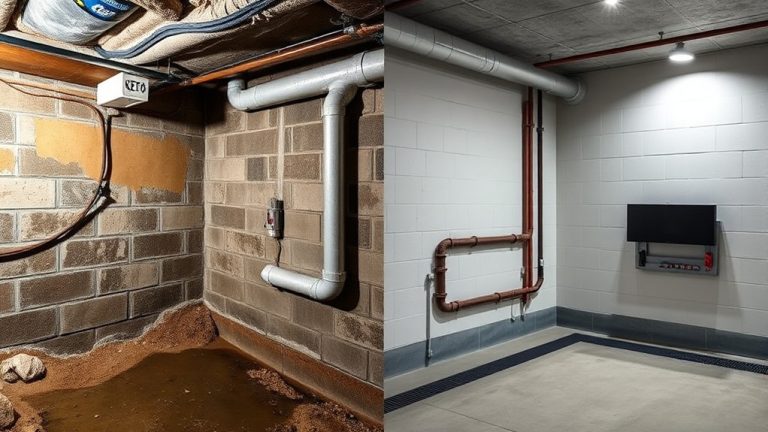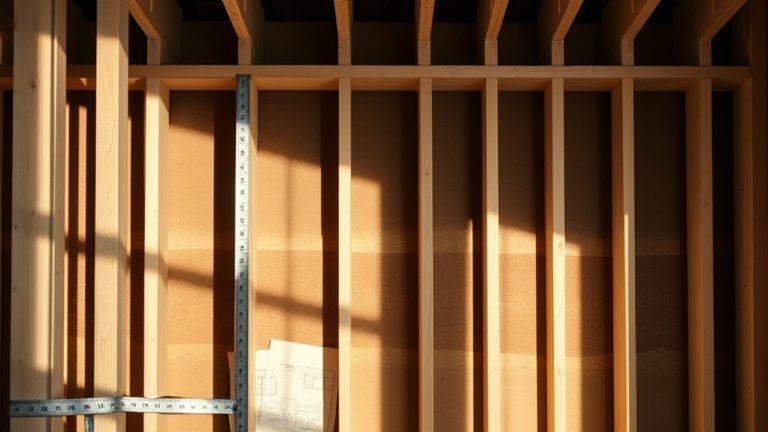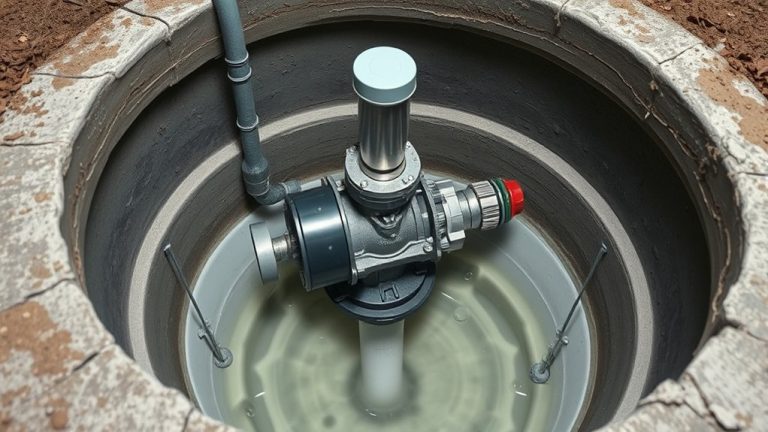Mold and mildew can turn your basement from a functional space into a health hazard. They thrive in damp, dark environments, silently spreading and causing damage you might not notice until it's too late. Comprehending how to prevent these unwelcome guests is pivotal for maintaining a healthy home. If you're worried about musty odors, water stains, or potential structural issues, you're not alone. Let's investigate how you can protect your basement and keep it dry, clean, and mold-free.
Key Takeaways
- Control indoor humidity levels between 30-50% using dehumidifiers and ensuring proper ventilation to create an environment that discourages mold and mildew growth.
- Seal basement walls and floors with concrete sealants and professional crack-sealing products to prevent moisture intrusion and block potential water entry points.
- Improve drainage around your home by maintaining gutters, downspouts, and yard grading to direct water away from the foundation and minimize moisture buildup.
- Enhance basement air circulation by installing window fans, portable fans, and upgrading cooling systems to promote consistent airflow and reduce humidity.
- Regularly inspect basement walls, floors, and potential moisture sources, addressing any signs of water damage or moisture accumulation immediately to prevent mold development.
Understanding Mold and Mildew Growth Conditions
Because mold and mildew thrive in specific environments, understanding their growth conditions is essential for effective prevention. You'll want to start by identifying moisture sources in your basement, which are the primary culprits behind these unwelcome guests. Monitoring temperature changes can help you pinpoint potential problem areas. Mold typically grows in damp, dark spaces with temperatures between 60-80°F, where humidity levels exceed 60%. By recognizing these conditions, you can take proactive steps to create an inhospitable environment for mold and mildew, protecting your home and health from potential damage and contamination. Basement waterproofing solutions can play a crucial role in preventing moisture accumulation and reducing the risk of mold growth.
Controlling Humidity and Moisture Levels
Since controlling humidity is essential in preventing basement mold, you'll want to aim for indoor humidity levels between 30-50%. A dehumidifier installation can help you achieve this goal, removing excess moisture from the air and creating an inhospitable environment for mold growth. Bowing wall stabilization methods can also help prevent moisture buildup and potential structural damage that might contribute to mold issues.
Moisture monitoring systems provide real-time tracking, alerting you to potential humidity issues before they become serious problems. By investing in these tools and staying vigilant, you'll protect your basement from dampness and mold. Regular monitoring and quick action can save you time, money, and stress in the long run.
Improving Basement Ventilation and Air Circulation
When moisture accumulates in your basement, poor air circulation can quickly convert a damp space into a breeding ground for mold and mildew. To combat this, you'll want to focus on strategic ventilation techniques that keep air moving and moisture at bay.
Install window fans to promote cross-ventilation
Upgrade cooling system to improve air exchange
Consider dehumidifier installation for consistent moisture control
Use portable fans to bolster air circulation
Waterproofing and Sealing Basement Walls and Floors
Water damage can wreak havoc on your basement, making waterproofing and sealing critical steps in mold prevention. You'll want to inspect basement walls and floors for cracks, which can be entry points for moisture.
Use specialized concrete floor sealants to protect against water intrusion and stop potential mold growth. Professional-grade basement crack sealing products can help you create an impenetrable barrier against dampness.
Proper Drainage and Exterior Maintenance
Because effective mold prevention starts outside your home, you'll want to focus on proper drainage and exterior maintenance to protect your basement from moisture infiltration. Landscaping adjustments and foundation repairs can greatly reduce moisture risks and prevent water from seeping into your basement.
Guarantee gutters and downspouts direct water at least 10 feet away from your foundation.
Grade your yard to slope away from the house, preventing water pooling.
Repair any cracks in foundation walls immediately.
Install French drains to redirect underground water flow.
Your proactive maintenance can save you from costly mold remediation and structural damage.
Choosing Mold-Resistant Materials and Treatments
After addressing exterior drainage and foundation protection, homeowners can further safeguard their basements by selecting the right materials and treatments. You'll want to invest in durable sealants that create a moisture barrier on walls and floors. Antimicrobial coatings can also provide an extra layer of defense against potential mold growth.
Consider using mold-resistant drywall, treated wood, and moisture-resistant paint when finishing your basement. These specialized materials won't guarantee complete prevention, but they'll substantially reduce the risk of mold and mildew developing in your underground space.
Regular Inspection and Maintenance Strategies
If you're serious about preventing mold and mildew in your basement, routine inspections and proactive maintenance are essential. Regular checks help you catch potential problems before they escalate, protecting your home's air quality and structural integrity.
Key maintenance strategies include:
- Perform monthly visual inspections of walls, floors, and corners
- Use air quality monitoring devices to detect hidden moisture
- Keep your basement organization neat and clutter-free
- Promptly address any signs of water intrusion or dampness
Staying vigilant and taking swift action can save you significant time, money, and stress in the long run.
Frequently Asked Questions
Q1: Can Mold Cause Serious Health Problems for My Family?
Yes, mold can trigger serious respiratory issues, allergies, and infections. Your basement's hidden moisture sources and poor ventilation needs can amplify health risks for your family's well-being.
Q2: How Quickly Does Mold Spread in a Damp Basement?
Mold can spread rapidly in damp basements, often within 24-48 hours when humidity levels exceed 60%. You'll want to maintain proper ventilation techniques to stop its aggressive growth and protect your living space's freedom.
Q3: What Are the Early Warning Signs of Mold Growth?
You'll spot mold's early signs through moisture condensation monitoring: discolored patches, musty odors, visible water stains, and peeling wallpaper. Early detection methods help you catch potential infestations before they spread wildly.
Q4: Is It Safe to Remove Mold Myself or Hire Professionals?
For small mold patches, you'll want to DIY with protective gear. Large infestations require professionals who'll assess ventilation requirements and install a moisture monitoring system, ensuring thorough, safe remediation.
Q5: How Expensive Are Professional Mold Remediation Services?
Professional mold remediation costs typically range from $500 to $6,000, depending on your basement's moisture control needs and the extent of the professional mold inspection required.



